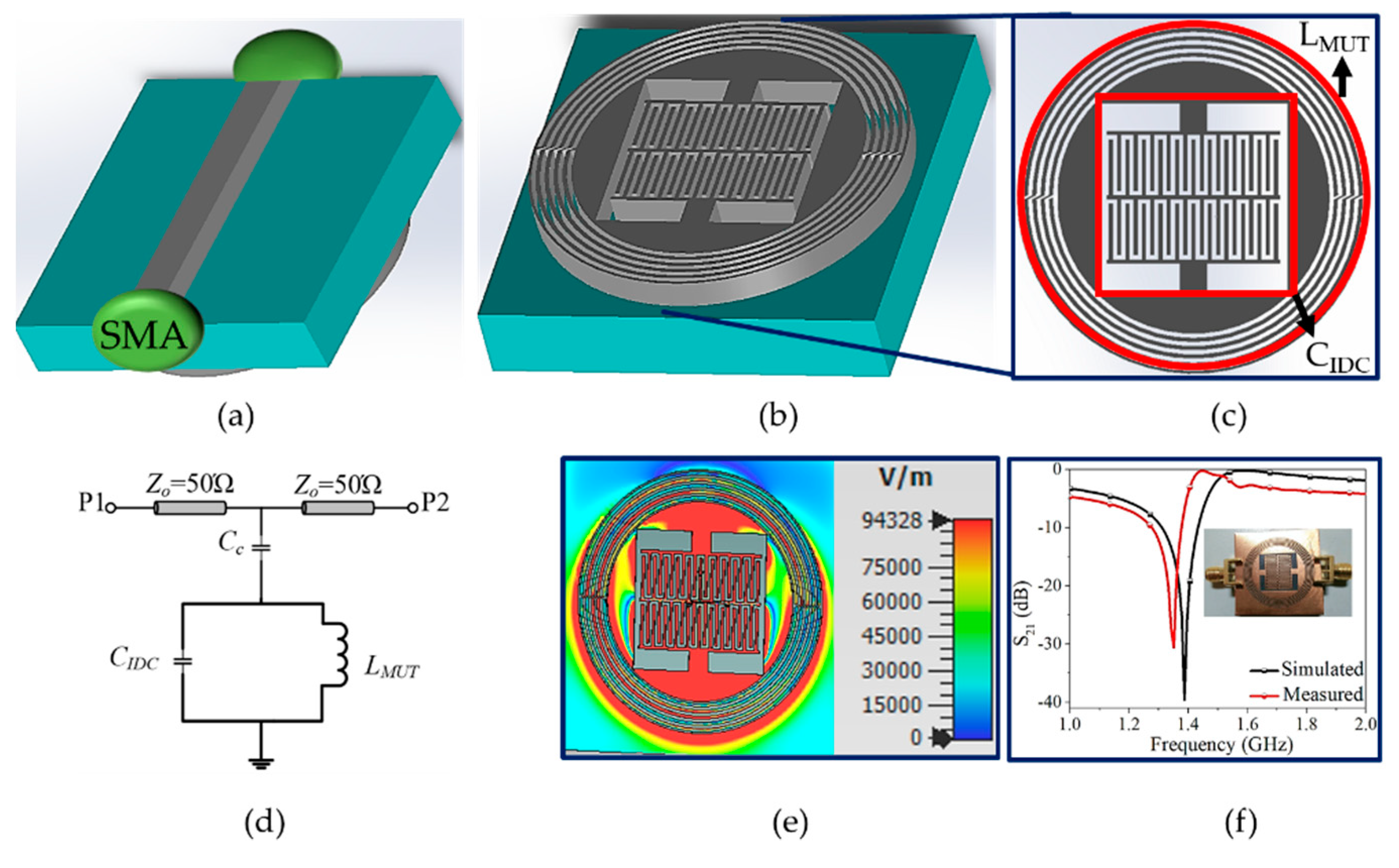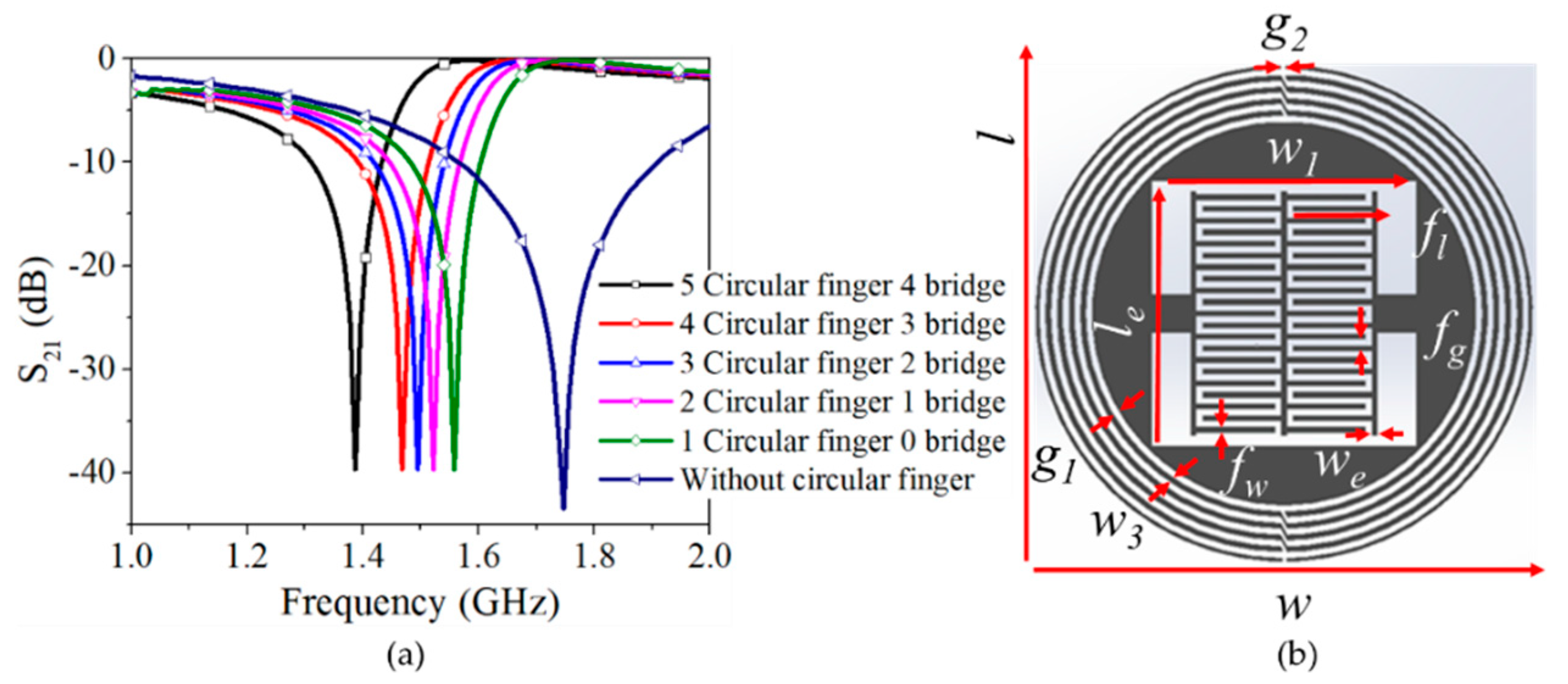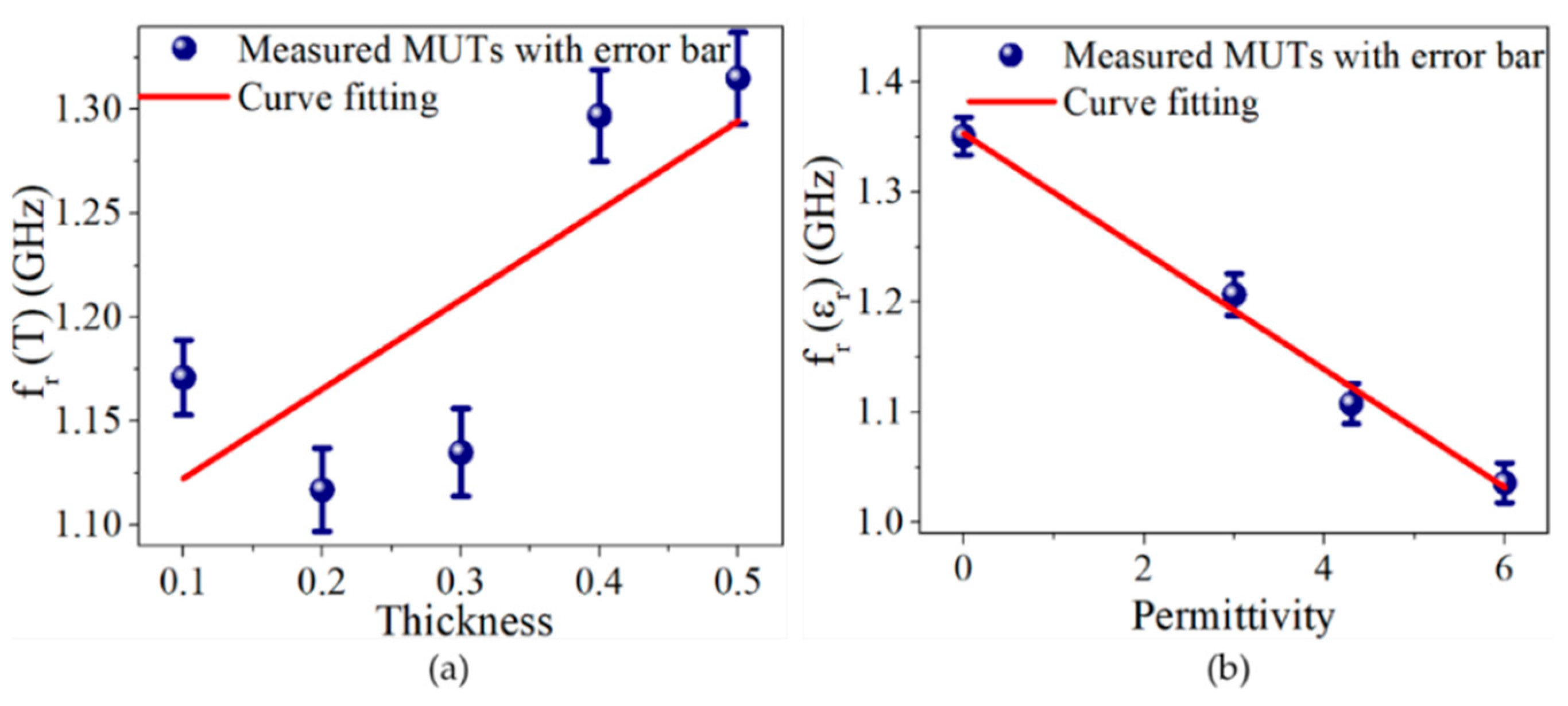Design and Optimization of Microwave Sensor for the Non-Contact Measurement of Pure Dielectric Materials
Abstract
:1. Introduction
2. Microwave Sensor Design and Operating Principle
2.1. Microwave Sensor Design
2.2. Operating Principle of the Design
3. Fabrication of the Proposed Design
4. Experimental Results and Discussion
4.1. Analysis of Complex Permittivity with Air Gap Scenario
4.2. Analysis of Thickness with Air Gap Scenario
5. Conclusions
Author Contributions
Funding
Data Availability Statement
Acknowledgments
Conflicts of Interest
References
- Safa, M.S.; Nayyeri, V.; Khanjarian, M.; Soleimani, M.; Ramahi, O.M. A CSRR-based sensor for full characterization of magneto-dielectric materials. IEEE Trans. Microw. Theory Tech. 2019, 67, 806–814. [Google Scholar] [CrossRef]
- Shi, P.; Gao, R.; Liu, S.; Yuan, Y. Topology optimization-based design of metamaterial-inspired sensor with improved sensitivity. Sens. Act. A Phys. 2017, 268, 83–90. [Google Scholar] [CrossRef]
- Subbaraj, S.; Ramalingam, V.S.; Kanagasabai, M.; Sundarsingh, E.F.; Selvam, Y.P.; Kingsley, S. Electromagnetic nondestructive material characterization of dielectrics using EBG based planar transmission Line sensor. IEEE Sens. J. 2016, 16, 7081–7087. [Google Scholar] [CrossRef]
- Kiani, S.; Rezaei, P.; Navaei, M.; Abrishamian, M.S. Microwave sensor for detection of solid material permittivity in single/multi-layer samples with high-quality factor. IEEE Sens. J. 2018, 18, 9971–9977. [Google Scholar] [CrossRef]
- Rusni, I.M.; Ismail, A.; Alhawari, A.R.H.; Hamidon, M.N.; Yusof, N.A. An aligned-gap and centered-gap rectangular multiple split-ring resonator for dielectric sensing applications. Sensors 2014, 14, 13134–13148. [Google Scholar] [CrossRef] [PubMed]
- Li, Y.; Bowler, N.; Jhonson, D.B. A resonant microwave patch sensor for detection of layer thickness or permittivity variations in multilayered dielectric structures. IEEE Sens. J. 2011, 11, 5–15. [Google Scholar] [CrossRef]
- Rahman, M.N.; Islam, M.T.; Samsuzzaman, S.M. Resonator based metamaterial sensor to detect unknown materials. Microw. Optical Technol. Lett. 2018, 60, 1681–1685. [Google Scholar] [CrossRef]
- Romera, G.G.; Martinez, F.J.H.; Gil, M.; Martinez, J.J.M.; Vargas, D.S. Submersible printed split-ring resonator-based sensor for thin-film detection and permittivity characterization. IEEE Sens. J. 2016, 16, 3587–3596. [Google Scholar] [CrossRef]
- Karami, M.; Rezaei, P.; Kiani, S.; Sadeghzadeh, R.A. Modified planar sensor for measuring dielectric constant of liquid materials. Electron. Lett. 2017, 53, 1300–1302. [Google Scholar] [CrossRef]
- Jankovic, N.; Radonic, V. A microwave microfluidic sensor based on a dual-mode resonator for dual-sensing applications. Sensors 2017, 17, 2713. [Google Scholar] [CrossRef] [Green Version]
- Benkhaoua, L.; Benhabiles, M.T.; Mouissat, S.; Riabi, M.L. Miniaturized quasi-lumped resonator for dielectric characterization of liquid mixtures. IEEE Sens. J. 2016, 16, 1603–1610. [Google Scholar] [CrossRef]
- Horestani, A.K.; Naqui, J.; Abbott, D.; Fumeaux, C.; Martin, F. Two dimensional displacement and alignment sensor based on reflection coefficients of open microstrip lines loaded with split-ring resonators. Electron. Lett. 2014, 50, 620–622. [Google Scholar] [CrossRef] [Green Version]
- Ebrahimi, A.; Withayachumnankul, W.; Sarawi, S.A.; Abbott, D. High-sensitivity metamaterial-inspired sensor for microfluidic dielectric characterization. IEEE Sens. J. 2014, 14, 1345–1351. [Google Scholar] [CrossRef] [Green Version]
- Mckeown, M.S.; Julrat, S.; Trabelsi, S.; Tollner, E.W. Open transverse slot substrate integrated waveguide sensor for biomass permittivity determination. IEEE Trans. Instrum. Meas. 2017, 66, 2181–2188. [Google Scholar] [CrossRef]
- Saghati, A.P.; Batra, J.S.; Kameoka, J.; Entesari, K. A meta-material inspired wideband microwave interferometry sensor for dielectric spectroscopy of liquid chemicals. IEEE Trans. Microw. Theory Tech. 2017, 65, 2558–2571. [Google Scholar] [CrossRef]
- Shafi, K.T.M.; Jha, A.K.; Akhtar, M.J. Improved planar resonant RF sensor for retrieval of permittivity and permeability of materials. IEEE Sens. J. 2017, 17, 5479–5486. [Google Scholar] [CrossRef]
- Yeo, J.; Lee, J.L. High sensitivity microwave sensor based on an interdigital capacitor shaped defected ground structure for permittivity characterization. Sensors 2019, 19, 498. [Google Scholar] [CrossRef] [Green Version]
- Alahnomi, R.A.; Zakaria, Z.; Ruslan, E.; Rashid, S.R.A.; Bahar, A.A.M. High-Q sensor based on symmetrical split ring resonator with spurlines for solids material detection. IEEE Sens. J. 2017, 17, 2766–2775. [Google Scholar] [CrossRef]
- Lee, H.J.; Lee, J.H.; Moon, H.S.; Jang, I.S.; Choi, J.S.; Yook, J.G.; Jung, H.L. A planar split-ring resonator-based microwave biosensor for label-free detection of biomolecules. Sens. Act. B Chem. 2012, 169, 26–31. [Google Scholar] [CrossRef]
- Velez, P.; Su, L.; Grenier, K.; Contreras, J.M.; Dubuc, D.; Martin, F. Microwave microfluidic sensor based on a microstrip splitter/combiner configuration and split ring resonators (SRRs) for dielectric characterization of liquids. IEEE Sens. J. 2017, 17, 6589–6598. [Google Scholar] [CrossRef] [Green Version]
- Ebrahimi, A.; Scott, J.; Ghorbani, K. Ultrahigh sensitivity microwave sensor for microfluidic complex permittivity measurement. IEEE Trans. Microw. Theory Tech. 2019, 67, 4269–4277. [Google Scholar] [CrossRef]
- Mamishev, A.V.; Du, Y.; Lesieutre, B.C.; Zahn, M. Development and applications of fringing electric field dielectrometry sensors and parameter estimation algorithms. J. Electrostat. 1999, 46, 109–123. [Google Scholar] [CrossRef]
- Rahman, M.S.A.; Mukhopadhyay, S.C.; Yu, P.L. Novel planar interdigital sensors. Smart Sens. Meas. Instrum. 2014, 10, 11–35. [Google Scholar]
- Bonache, J.; Gil, M.; Gil, I.; Garcia, J.; Martin, F. On the electrical characteristics of complementary metamaterial resonators. IEEE Micro. Wirel. Comp. Lett. 2006, 16, 543–545. [Google Scholar] [CrossRef]
- Sun, H.R.; Du, G.; Liu, G.; Sun, X.; Tang, T.; Liu, W.; Li, R. Symmetric coplanar waveguide sensor loaded with interdigital capacitor for permittivity characterization. Int. J. RF Microw. Comput. Eng. 2020, 30, e22023. [Google Scholar] [CrossRef]
- Kapoor, A.; Varshney, P.K.; Akhtar, M.J. Interdigital Capacitor Loaded Electric-LC Resonator for Dielectric Characterization. Microw. Opt. Technol. Lett. 2020, 62, 2835–2840. [Google Scholar] [CrossRef]
- Yang, C.L.; Lee, C.S.; Chen, K.W.; Chen, K.Z. Non-contact measurement of complex permittivity and thickness by using planar resonators. IEEE Trans. Microw. Theory Tech. 2016, 64, 247–257. [Google Scholar] [CrossRef]
- Wang, C.; Ali, L.; Meng, F.; Adhikari, K.K.; Zhou, Z.L.; Wei, Y.; Zou, D.Q.; Yu, H. High accuracy complex permittivity characterization of solid materials using parallel interdigital capacitor-based planar microwave sensor. IEEE Sens. J. 2020, 21, 6083–6093. [Google Scholar] [CrossRef]
- Keat, G.O.; Craig, A.G. A resonant printed-circuit sensor for remote query monitoring of environmental parameters. Smart Mater. Struct. 2000, 9, 421–428. [Google Scholar]
- Nurage, N.; Su, K. Perovskite ferroelectric nanomaterials. Nanoscale 2013, 5, 8752–8780. [Google Scholar] [CrossRef] [PubMed]
- Chen, J. On-Chip Spiral Inductor Transformer Design and Modeling for RF Applications. Ph.D. Thesis, University of Central Florida, Orlando, FL, USA, 2006. [Google Scholar]
- Ebrahimi, A.; Scott, J.; Ghorbani, K. Transmission lines terminated with LC resonators for differential permittivity sensing. IEEE Microw. Wirel. Compon. Lett. 2018, 28, 1149–1151. [Google Scholar] [CrossRef]
- Ali, L.; Wang, C.; Meng, F.; Adhikari, K.K.; Wei, Y.; Li, J.H.; Song, Z.W.; Zhao, M. Design and optimization of interdigitated microwave sensor for multidimensional sensitive characterization of solid materials. IEEE Sens. J. 2021, 21, 22814–22822. [Google Scholar] [CrossRef]
- Su, L.; Contreras, J.M.; Velez, P.; Martin, F. Configurations of splitter/combiner microstrip sections loaded with stepped impedance resonators (SIRs) for sensing applications. Sensors 2016, 16, 2195. [Google Scholar] [CrossRef] [Green Version]
- Ebrahimi, A.; Beziuk, G.; Scott, J.; Ghorbani, K. Microwave differential frequency splitting sensor using magnetic-LC resonators. Sensors 2020, 20, 1066. [Google Scholar] [CrossRef] [PubMed] [Green Version]
- Ali, L.; Wang, C.; Meng, F.; Wei, Y.; Tan, X.; Adhikari, K.K.; Zhao, M. Simultaneous measurement of thickness and permittivity using microwave resonator-based planar sensor. Int. J. RF Microw. Comput. Eng. 2021, 31, e22794. [Google Scholar] [CrossRef]










| Parameters | Abbreviation | Minimum Value | Optimized Value | Maximum Value |
|---|---|---|---|---|
| fw | Finger width | 0.1 | 0.3 | 0.4 |
| fg | Finger gap | 0.2 | 0.325 | 0.5 |
| le | Length of electrode | 7.0 | 12.5 | 14.0 |
| we | Width of electrode | 0.1 | 0.3 | 0.5 |
| fl | Finger length | 2.0 | 4.0 | 6.0 |
| w1 | Gap between electrode | 6.0 | 9.0 | 12.0 |
| w3 | Width of circular finger | 0.1 | 0.31 | 0.5 |
| g1 | Gap between circular finger | 0.1 | 0.31 | 0.5 |
| g2 | Gap between bridge-type structure | 0.15 | 0.3 | 0.45 |
| l | Length of the proposed design | -- | -- | 15 |
| w | Width of the proposed design | -- | -- | 15 |
| References | fr (GHz) | S (%) | FDR (MHz) | Maximum Gap (mm) | Sensing Accuracy | |
|---|---|---|---|---|---|---|
| [1] | 2.47 | 3.25–6.2 | 1.7 | 40 | 0 | -- |
| [3] | 2.45 | 2.09–6.92 | 0.5 | 10 | 0 | -- |
| [28] | 2.35 | 2.2–10.5 | 3.98 | 290 | 0 | 99.9% and 99.7% |
| [32] | 2.0 | 2.2–10.2 | 3.3 | 225 | 0 | -- |
| [33] | 5.79 | 1.6–6.15 | 4.3 | 373 | 0 | 99% and 97% |
| [34] | 3.6 | 2.43–10.2 | 1.2 | 210 | 0 | -- |
| [35] | 2.18 | 2.2–10.7 | 3.59 | 245 | 0 | -- |
| [36] | 1.8 | 2.2–10.5 | 3.39 | 63 | 0 | 99% and 87% |
| Proposed design | 1.38 | 3–6 | 0.51 | 7.2 | 0.3 | 97% and 92% |
| Sample | Reference tanδ | Extracted tanδ | Error (%) | ||
|---|---|---|---|---|---|
| FR4 | 3.0 ± 0.2 | 3.05 | 0.025 | 0.0237849 | 3.86 |
| Rogers | 4.3 ± 0.15 | 4.25 | 0.001 | 0.0015649 | 4.49 |
| Mica | 6.1 ± 0.2 | 6.15 | -- | -- | 6.52 |
Publisher’s Note: MDPI stays neutral with regard to jurisdictional claims in published maps and institutional affiliations. |
© 2021 by the authors. Licensee MDPI, Basel, Switzerland. This article is an open access article distributed under the terms and conditions of the Creative Commons Attribution (CC BY) license (https://creativecommons.org/licenses/by/4.0/).
Share and Cite
Ali, L.; Wang, C.; Ullah, I.; Yousaf, A.; Khan, W.U.; Ullah, S.; Khan, R.; Alassery, F.; Hamam, H.; Shafiq, M. Design and Optimization of Microwave Sensor for the Non-Contact Measurement of Pure Dielectric Materials. Electronics 2021, 10, 3057. https://doi.org/10.3390/electronics10243057
Ali L, Wang C, Ullah I, Yousaf A, Khan WU, Ullah S, Khan R, Alassery F, Hamam H, Shafiq M. Design and Optimization of Microwave Sensor for the Non-Contact Measurement of Pure Dielectric Materials. Electronics. 2021; 10(24):3057. https://doi.org/10.3390/electronics10243057
Chicago/Turabian StyleAli, Luqman, Cong Wang, Inam Ullah, Adnan Yousaf, Wali Ullah Khan, Shafi Ullah, Rahim Khan, Fawaz Alassery, Habib Hamam, and Muhammad Shafiq. 2021. "Design and Optimization of Microwave Sensor for the Non-Contact Measurement of Pure Dielectric Materials" Electronics 10, no. 24: 3057. https://doi.org/10.3390/electronics10243057








